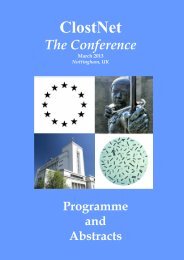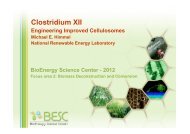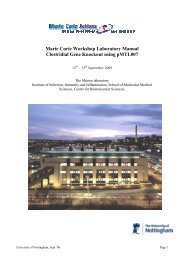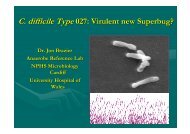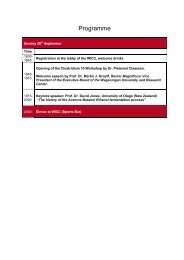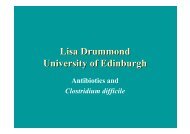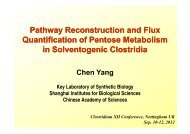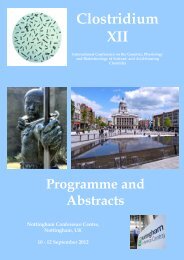abstract book - Clostridia
abstract book - Clostridia
abstract book - Clostridia
Create successful ePaper yourself
Turn your PDF publications into a flip-book with our unique Google optimized e-Paper software.
EFFECT OF CARBON DIOXIDE ON NEUROTOXIN GENE<br />
EXPRESSION IN NON-PROTEOLYTIC CLOSTRIDIUM BOTULINUM<br />
TYPES B AND E<br />
I. Artin 1,2,3 , A.T. Carter 2 , E. Holst 3 , M. Lövenklev 1 , D.R. Mason 2 , M.W.<br />
Peck 2 , and P. Rådström 1<br />
1 Applied Microbiology, Lund Institute of Technology, Lund University,<br />
SE-221 00 Lund, Sweden, 2 Institute of Food Research, Norwich<br />
Research Park, Colney, Norwich, NR4 7UA, UK, 3 Division of Medical<br />
Microbiology, Department of Laboratory Medicine, Lund University, SE-<br />
223 62 Lund, Sweden.<br />
When developing new food products and manufacturing solutions, it is<br />
important to consider not only the occurrence and quantity of<br />
pathogens in the food chain, but how the processing and subsequent<br />
storage and handling will affect them. This is especially relevant for<br />
food designed to have a long shelf-life. Understanding the influence of<br />
environmental factors, food preservatives, and type of packaging on<br />
microbial growth and expression of virulence factors is very important.<br />
Quantitative reverse transcription PCR (qRT-PCR) and enzyme-linked<br />
immunosorbent assay (ELISA) were used to monitor neurotoxin gene<br />
(cnt) expression and neurotoxin formation in non-proteolytic C.<br />
botulinum types B and E. Relative gene expression varied with growth<br />
phase in both types, reaching a maximum in late exponential and early<br />
stationary phase.<br />
We also found that while growth was slowed, relative cnt expression<br />
was increased with an elevated CO 2 concentration, with five-fold<br />
greater expression of cntB mRNA and accumulation of type B toxin at<br />
70% CO 2 than at 10%. For type E the increase in expression at 70%<br />
CO 2 was two-fold greater, when compared with 10% CO 2 .<br />
In conclusion, these findings, shown with both qRT-PCR and ELISA,<br />
sheds a new cautionary light on the potential risks of botulism<br />
associated with non-proteolytic C. botulinum and the use of modified<br />
atmosphere packaging.<br />
17



